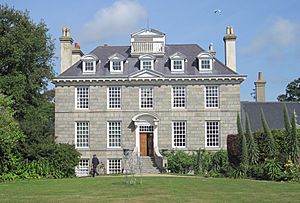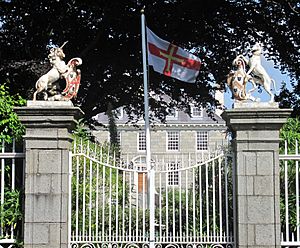Sausmarez Manor facts for kids
Sausmarez Manor is a very old house located in Saint Martin, Guernsey. It has been home to the Sausmarez family for many centuries. This historic manor has seen many changes and additions over time, reflecting different periods in history.
Contents
The First Manor House
The Sausmarez family has lived in Guernsey for a very long time. They were first mentioned in records around 1117. Later, in 1254, a family member named William de Saumareis was involved in an important inquiry. He was a knight and owned land in both Guernsey and Jersey.
The first manor house was built on the same spot as the current one. In 1313, Matthew de Sausmarez was the Captain of Jerbourg Castle and the owner of the Manor. The family's ownership of the land was confirmed in 1331.
In 1338, the French captured Guernsey. Sir Peter de Sausmarez had to escape to Jersey. He returned in 1345 after the island was taken back.
Only a small part of this very old manor house still exists today. It's a strong stone wall that forms part of an outbuilding. This wall has an arched doorway that was later filled in. It's one of the oldest untouched Norman stone structures on the island, dating back to the mid-1200s.
The Tudor House
The manor stayed with the Sausmarez family until 1557. That year, the owner, George de Sausmarez, passed away without children. He left his estate to his sister, Judith. She had married an Englishman named John Andrews.
Their son, also named John, became the new owner of the manor. He was known as John Andros in Guernsey. He built the second house in 1585. This house was built at a right angle to the original one. You can still see his initials, I.A., and the date 1585 carved above a doorway inside.
Today, the lower part of this house is a workshop where metal crafts are made. The upper part has been updated over the years and is still lived in.
The Queen Anne House
Six members of the Andros family owned Sausmarez Manor for almost 200 years. One important owner was Amyas Andros. He was very loyal to the King during the Civil War. He helped connect the King's forces in Jersey with the royalist soldiers in Castle Cornet. After the war, he became the Bailiff of Guernsey.
His son, Sir Edmund Andros, was also very important. In 1674, he was Bailiff of Guernsey and also Governor of many places in America, including New York. He was the one who changed the name from New Amsterdam to New York. Sir Edmund didn't spend much time in Guernsey.
Sir Edmund thought the old Tudor house wasn't grand enough. In his will, he asked his nephew, John, to build a "good suitable house" within five years. If not, John would have to pay a large sum of money.
My will is that my said nephew, John, shall build within five years of my death a good suitable house on or at the manor of Sasmares in Guernsey and if the said John or his heirs shall not in that time have built such house (if not built before) then my will is and I appoint my said nephew John or his heirs to pay the sum of £500 unto my nephew George Andros within one year after his or their neglect.
John Andros built the beautiful new house between 1714 and 1718. It was likely designed in London before Sir Edmund passed away.
The new house is made of grey granite with red granite corners. Its outer walls are two feet thick! It has four floors with two rooms on each. The main entrance is on the first floor, reached by eight steps. Inside, a grand staircase goes all the way to the top. From the top, there's a "widows walk" with a great view of most of the island.
In 1746, Charles Andros became the owner. Just two years later, he sold the house back to the de Sausmarez family.
The de Sausmarez family had lost the manor when Judith married John Andros. Some family members became wool merchants, selling goods in France. But the wool trade declined because of new fashions.
However, Matthew de Sausmarez (born 1685) was a clever and energetic man. He married a wealthy woman and used her money to fund "privateers." These were private ships that attacked enemy ships during wartime, legally capturing their goods. This was a very profitable business in the 1700s. Matthew was also a lawyer in Guernsey.
His son, John, also became a lawyer. His second son, Philip, joined the Royal Navy. Philip sailed around the world with Commodore George Anson. He even commanded a very rich Spanish ship that was captured. Philip was killed in battle, but he left a lot of money to his family. This money helped John buy back the manor in 1748. Another son, Matthew, was the father of the famous Admiral James Saumarez, 1st Baron de Saumarez.
After getting his family home back, John de Sausmarez put up the famous gates on Sausmarez Road. The outer pillars of the gates have the family's falcon symbol. The inner pillars have a unicorn and a greyhound, which are symbols from the family's coat of arms. These gates were made by Sir Henry Cheere, a famous sculptor from the 1700s. In 1759, John also updated the upper part of the Tudor manor house.
The Regency House
John's oldest son, Matthew, owned the manor from 1774 to 1820. He added walls around the vegetable garden, orchard, and tennis court. He also fixed up an old barn.
When Matthew passed away, his brother Thomas became the owner. Thomas had a very large family with 28 children from two marriages. Many of his children were still young when he moved into the Manor. The Andros house was too small for them all.
So, Thomas built an addition to the back of the house. It had a large breakfast room and several bedrooms. A hallway separated it from the Queen Anne house. Part of what is now the kitchen was once Thomas's office.
Not much of this "Regency house" remains today. Some doors and windows are still there. Most of it was taken down by Thomas's youngest son, General George de Sausmarez. He bought out his brothers' shares of the property. In 1873, he began the last major additions to the family home.
The Victorian House
General George de Sausmarez had a successful career in the East India Company. He was an expert in training soldiers and improving military management. He never fought in a war, but his command in India was the only one that didn't have any rebellions. His job was very profitable, which allowed him to make big changes to the manor when he returned to Guernsey.
He tore down most of his father's Regency house. In its place, he built a large dining room and an even larger drawing-room on the first floor. From the outside, the windows and design of these rooms look very different from the Queen Anne part of the house. However, the inside of these rooms has a special charm.
The General also built a large entrance hall on the north-east side of the Queen Anne house to connect it to the Tudor house. This hall is famous for its amazing wood carvings. Some carvings are from Burma, others are copies made by a local artist. There are also carvings of Old Testament figures and scenes, which are thought to have come from churches in France. This mix of styles creates a unique and interesting look.
After the General passed away, his widow lived at the Manor until 1915. Her nephew, Sir Havilland de Sausmarez, then became the owner. He had a distinguished career as a judge in China for 16 years. He later became the Bailiff of Guernsey. He passed away during the German occupation of the island. He had refused to install electric lights, which saved the manor from being taken over by the German forces.
His nephew, Cecil de Sausmarez (1907-1986), then became the owner. He had a successful career in diplomacy. He also worked hard to restore and modernize the property.
See also
- Artparks Sculpture Park



